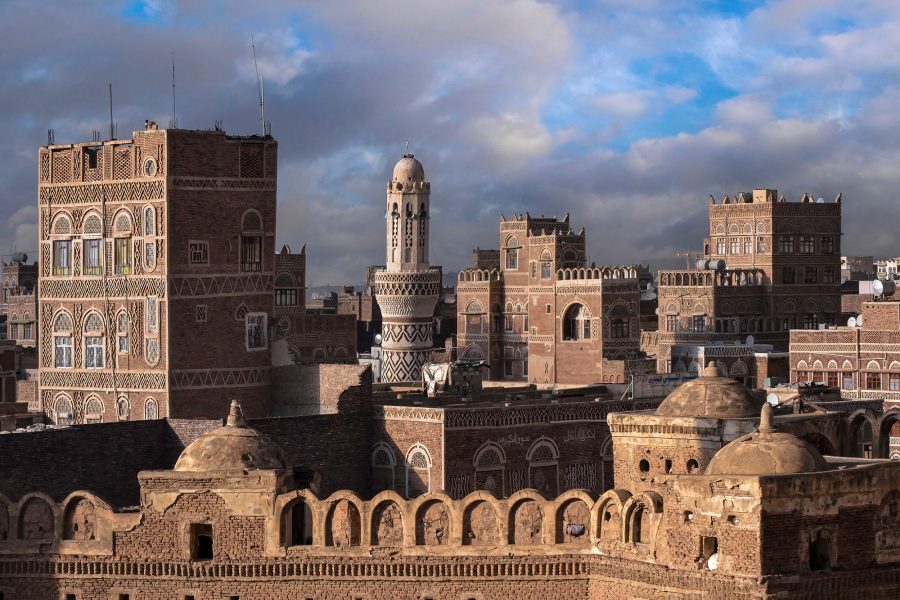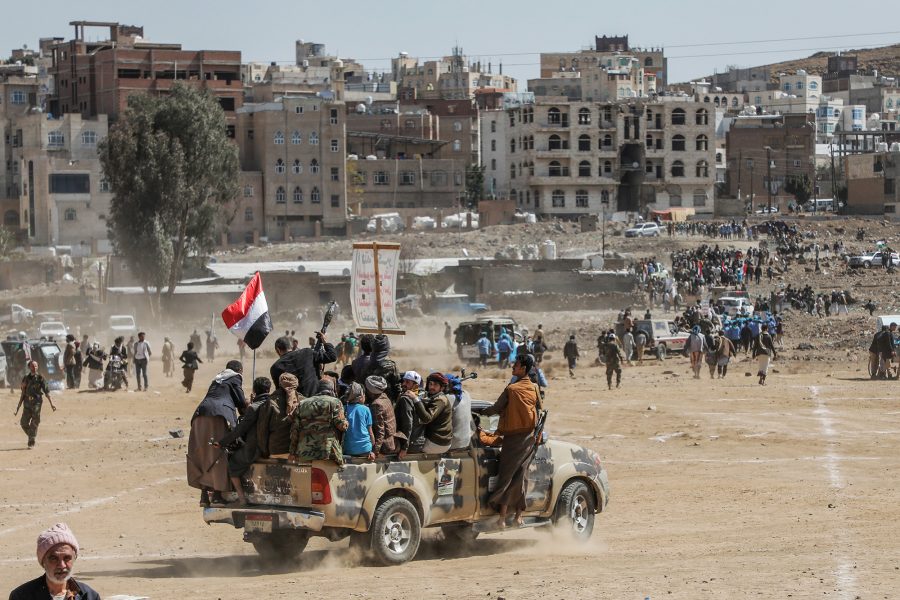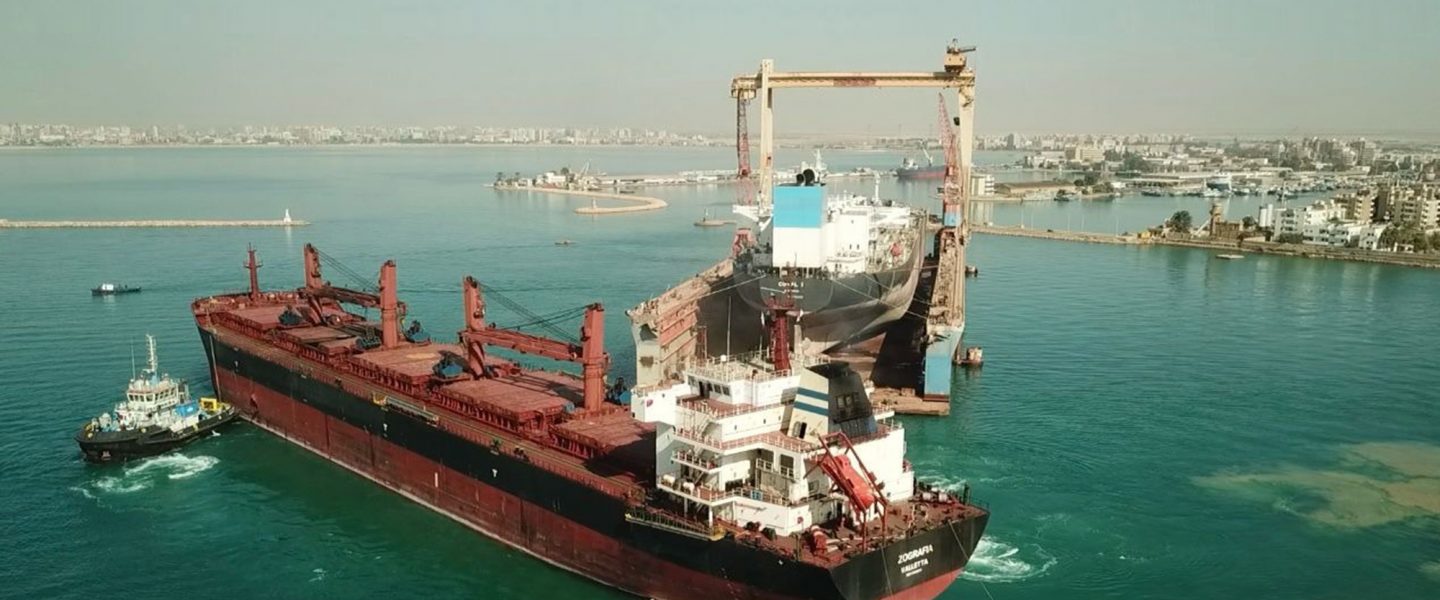With Houthi rebels threatening access to the Suez Canal, Yemen is staking out a larger role in Middle East turmoil.
|
Listen To This Story
|
Some wars are intentional. Others just happen, usually as the result of a chain reaction of events that take on an unintended pattern of their own. No grand strategy is involved. Each step in the path leading to an ultimate calamity is nothing more than a rational response to the event that just preceded it.
That is what appears to be taking place with Yemen’s Houthis. The last thing President Joe Biden wants in an election year is to see the US dragged into another Middle East quagmire. He may not have any choice.
While the carnage between Israelis and Palestinians in Gaza is terrible, that crisis has very little direct impact on the life of the average American. The Yemeni Houthis’ threat to block traffic through the Suez Canal could be different. In an increasingly globalized economy, roughly 80 percent of the planet’s commerce travels by ship. Between 12 and 15 percent of that traffic transits the Suez Canal.
More importantly, anywhere from 25 percent to 30 percent of the world’s container traffic goes through the canal. The only alternative is to sail around the entire continent of Africa. That can add anywhere from 3,500 to 4,000 miles and 10 or more extra days to the voyage. The added fuel costs can run anywhere from a half million to a million dollars per trip. Faced with the threat of rocket and missile attacks from the Houthis, a growing number of ship owners prefer the extra expense of the long route around Africa. Traffic through the Suez Canal has already dropped by around 45 percent.
Although the immediate impact is likely to be price rises in Europe, sooner or later everyone will be hit by higher prices. In a world that has ceded much of its manufacturing to China and Southeast Asia, buying almost anything at a Walmart, Target, or your favorite big box store is going to be more expensive. Biden had hoped to put an end to US inflation. The Houthis may be on the brink of killing that hope.
A Long History in a Key Spot
Although its geographic perch at the southwestern edge of the Arabian Peninsula might seem remote, Yemen has often played an important role in history, thanks to its strategic location. By the 3rd and 4th centuries CE, it had already positioned itself as an important crossroads for trade among Asia, Africa, and the Mediterranean. Mocha (also spelled Mokha) — formerly the principal port serving Yemen’s capital, Sanaa — once exercised a near monopoly over the world’s supply of coffee, which was grown in Ethiopia and then shipped by Somali sailors to Mocha for resale and export.

By the middle of the 19th century, Yemen was nominally part of the Ottoman Empire. When an early British steamship, the Hugh Lindsay, made an impressively fast voyage from India to Suez in 1830, it stopped for supplies and refitting at Aden on the southern coast of Yemen. Britain decided that the location would make an ideal port of call for ships on the trade route to India and, in 1839, the British East India Company dispatched Royal Marines to seize the port of Aden and start a settlement. Aden was soon declared a British protectorate, initially administered as part of Britain’s government in India.
The opening of the Suez Canal, in 1869, dramatically increased Aden’s importance. In 1937 Aden became a full-fledged British colony in its own right. During 1955 alone, some 5,239 ships docked in Aden, making it the world’s second busiest port after New York. But the British colonial administration also found itself forced to deal with increasing labor unrest, tribal attacks along the border with North Yemen, and a rising tide of anti-colonial Arab nationalism.
After Egypt attacked Israel in the Six-Day War, traffic through the canal was halted from 1967 through 1975. This resulted in Aden taking a heavy financial hit; in 1963 Britain decided it was time to end its colonial administration and grant Aden independence. Initially, it intended to reunite Aden with Sanaa in North Yemen, but the effort foundered, mostly because Aden was materially and politically much more cosmopolitan than North Yemen, which still seemed stuck somewhere in the Middle Ages. A similar attempt to unite the port of Aden with South Yemen’s settlements to the east and west of Aden also failed.
While South Yemen had its problems with labor protests and strikes, the North was increasingly influenced by radical ideas concerning Arab nationalism, exacerbated by Egypt’s charismatic President Gamal Abdel Nasser’s attempts to establish control throughout the Arab world. To complicate matters, Saudi Arabia also did its best to incite unrest among Yemeni tribes along its border.
As soon as the British departed, South Yemen took a hard turn to the left. In the early days of independence, it allied itself with the former Soviet Union, and Aden became a significant port for Soviet shipping. Britain’s withdrawal, it turned out, had done nothing to resolve South Yemeni politics. In 1986 a confrontation between Aden’s parliament and President Ali Nasser Mohammed Husani led to armed clashes that left at least 9,000 people wounded or killed in a crisis that briefly approached a full-blown civil war.
Britain’s royal yacht Britannia, en route to New Zealand at the time, had to be diverted to Aden in order to evacuate 400 British subjects. British families found themselves wading into the surf to reach the Britannia. Small boats from Soviet ships were pressed into service. When the Britannia came under heavy fire, the ship had to abandon the remaining expats on the beach. It returned a short while later to pick up another 200 evacuees. Soviet ships transported hundreds of their own nationals to safety in Djibouti.
As if South Yemen’s politics weren’t complicated enough, the Saudi Arabian branch of al-Qaeda merged with al-Qaeda’s Yemeni branch in 2009 and rebranded itself in Aden as “al-Qaeda in the Arabian Peninsula.” The merged organization took in a number of Saudi nationals who had been released from the US detention camp at Guantanamo in Cuba.
Hamas’s bloody attack against Israel and Israeli Prime Minister Benjamin Netanyahu’s rampage through Gaza, along with worldwide outrage over Israel’s treatment of Palestinians in general, gave the Houthis an opportunity to finally force the West, and especially the United States, to pay attention to their cause.
While reunited Yemen harbored more than its share of radicals, it continued to maintain relations with the West, although it was finding that increasingly difficult. In 2009, the Yemeni army and Saudi forces launched an offensive against Shia insurgents and the US unleashed volleys of cruise missiles and drone strikes at what Washington believed to be al-Qaeda training camps. None of it worked. Instead of eliminating al-Qaeda, several of the missiles hit Yemeni villages, killing dozens of civilians
Some Personal Notes on the Conflict
When the government in Sanaa reunited with Aden in May 1990, I was assigned to cover the story. The first place I went was Sanaa, the capital of North Yemen. My immediate impression was that these were mountain people. The atmosphere reminded me of Afghanistan, except that back then Kabul seemed a good deal more cosmopolitan. Although Sanaa was definitely picturesque, it looked straight out of the Middle Ages. It abounded with residential towers rising as many as eight stories — built of mud bricks and pressed earth atop stone foundations. The facades were decorated with white plaster ornamentation that resembled icing on a wedding cake.
In Sanaa, most men carried a jambiya — a short, broad-bladed dagger with an ornate handle — visibly tucked into their belt. The ornamental handle supposedly signified status in a society strongly based on hierarchy.
“They don’t actually use those?” a friend asked in a bar one night. “Don’t kid yourself,” said an Irish nurse who worked in the emergency room of Sanaa’s main hospital. “Every Friday night, the wounded come in by the truckloads.”
Walking along the sidewalk, I saw an old man being taunted by a teenager who danced a light jig while hurling insults. The old man took out his jambiya, held it high over his head, and chased the teenager down the street. Sanaa was picturesque, but clearly from a different century.
Aden, in contrast, seemed both more modern and more threatening. Most of the hotels and businesses I encountered displayed a kind of “Do Not Enter” sign, with a red circle and diagonal stripe, similar to the signs you see indicating the wrong-way entrance to a one-way street — only these signs had an image of a revolver on one side and a knife on the other. They were a not-so-subtle warning to leave weapons at the door.
Most offices in the Middle East have a picture of the king or president hanging on the wall. In many of Aden’s offices and shops, the pictures on the wall were of four leaders of the 1986 insurrection who had been executed shortly after it was over. This was a place, I decided, where anyone running for the presidency was likely to be cautious about exposing himself.
When I asked about the 1986 insurrection and the emergency evacuation of Western nationals, I was told that it had been triggered by the pro-Soviet South Yemen parliament’s decision to fire Hasani, who, although he gave lip service to being in the Soviet camp, was still considered too friendly with the US and Western Europe.
If the US had experienced its Wild West in the late 1800s, Aden was the Wild East. Hasani, I was told, had simply walked out of the parliament building and telephoned the air force, casually ordering them to launch a series of airstrikes against the recalcitrant parliament. I never found out whether the story was accurate, but it seemed to fit the atmosphere, which still lingered on during the period that was supposed to lead to unification. As for Hasani, he had prudently skipped the country.
The irony at the time was that Aden had everything it needed to become wealthy if it could manage to tap into the shipping traffic headed for the Red Sea and the Suez Canal. Reestablishing Aden as a major port offered ship owners the advantage of not having to go the extra distance to Dubai or the United Arab Emirates for refueling and refitting. That meant saving the expense of several extra days sailing and fuel costs.
Unfortunately, though, Yemen’s politics were too turbulent for the country ever to get its act together.
It did not help that Britain, Europe, Saudi Arabia, and the US had actively thrown their support behind the northern government in Sanaa and its president at the time, Ali Abdullah Saleh. At a quick glance, Saleh seemed a better bet for stability than the leaders of the turbulent South, but no one had counted on the residual Arab nationalism that still considered Britain, the US, and Europe to be potential colonial usurpers. Yemen wanted nothing to do with Saudi Arabia, which the US saw as vital to its interests but which the Yemenis, most of whom were Zaydi Shiite Muslims, saw as proselytizing the austere Saudi version of Sunni Islam.
The Arab Spring of 1992 was the final straw that led to Saleh’s overthrow and replacement by Abed Rabbo Mansour Hadi. With an increasing number of factions vying for power and no clear winner, Yemen saw itself sliding into a prolonged civil war. In 2014, Hadi, facing a collapsing economy, made a drastic gamble by eliminating fuel subsidies for a population that was already at the end of its economic rope. Strikes and rioting followed.

What Next in This Tinderbox?
Yemen remains a highly hierarchical, tribal society. Connections mean a great deal. With the country slipping into chaos, the Zaydi Yemenis gathered around Abdul Malik al-Houthi, a powerful northern tribal leader, and marched into Sanaa. Facing very little resistance, they took over the capital in what came to be known as the Battle of Sanaa. Hadi’s government sought to coexist for a time and then simply gave up. The semi-permanent civil war that followed has resulted in the Houthis taking power over most of the country, but it has also transformed Yemen into a humanitarian catastrophe. The United Nations estimates that 24.1 million people in Yemen, roughly 80 percent of the population, are currently in desperate need of humanitarian aid and protection.
Although just about everyone agrees that the situation is horrific, it has been treated as largely a problem that is happening somewhere else: an unfortunate dispute between Iran, which backs the Houthis, and Saudi Arabia, which is rich enough to do as it pleases. Most Americans, even the small minority who can point to Yemen on a map, don’t really care. Yemen is just another calamity that no one can do much about. At least that was the situation until October 7, 2023.
Hamas’s bloody attack against Israel and Israeli Prime Minister Benjamin Netanyahu’s rampage through Gaza, along with worldwide outrage over Israel’s treatment of Palestinians in general, gave the Houthis an opportunity to finally force the West, and especially the United States, to pay attention to their cause.
By connecting their situation to the plight of Palestinians in Gaza, and effectively cutting off traffic through the Red Sea and the Suez Canal, the Houthis could play the role of heroes, protecting the Palestinians while establishing themselves as significant players in the emerging turmoil in the Middle East. Leveraging canal traffic might be the key to being offered a seat at the table. The Houthis may also have thought that threatening shipping through the canal provided an excellent opportunity to demonstrate their power to their only major benefactor in the region, Iran.
But Iran may be starting to have second thoughts about its vaunted “Axis of Resistance.” While it may have hoped to harass the US and Israel through its surrogates while staying behind the scenes and escaping retaliation itself, the current carnage in Gaza could be a preview of what can happen when the surrogates step over the line and get it wrong.
It’s becoming increasingly clear that the surrogates — Hamas, Hezbollah, the Houthis, and a scattered range of subgroups — each have their own agendas. Iran has only tenuous control over what they might do next.
Ayatollah Ali Khamenei, Iran’s current omnipotent supreme leader, is 84 years old and reaching the end of his biological tether. It is a fairly safe prediction that Iran will soon face a transition at the top. The basic notion of Iran’s Axis of Resistance came from the al-Quds division of Iran’s Revolutionary Guards, which oversees most of Iran’s foreign terrorist operations. But the Revolutionary Guards are just one faction competing for the power to define Iran’s future. Politics in Tehran tend to be opaque, and it is anyone’s guess who will emerge on top.
For Biden and US Secretary of State Antony Blinken, the current confrontation over shipping in the Red Sea is just another piece of a much larger puzzle. It is also a reminder that if you find yourself forced to react to one crisis after another, it can be difficult to stay ahead of the game. With a growing number of attacks against American installations in the region, the game threatens to slip into a new phase, with new rules, a new board, and new stakes. That may make the situation more complicated and dangerous than any of the players really wants.




